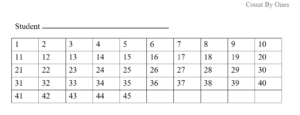MAFS.K.CC.1.1: Count to 100 by ones and by tens.
Cognitive Complexity Level: 1-Recall
[divider] [/divider] Students are able to…
- Sequentially count to 100 by ones.
- Sequentially count to 100 by tens.
- Recognize patterns that make up the counting sequence.
- Match the number name the written numeral.
[divider] [/divider] Students are able to…because teachers:
- Provide visual aids such as hundreds charts and number lines.
- Guide students to see patterns in the counting sequence as students count by ones and tens.
- Give frequent practice for students to count by ones and tens.
- Introduce students to sets of numbers as they learn to rote count.
- Use a hundreds chart to help students count across decades. (ie. 19-20, 29-30, etc.)
[divider] [/divider] Questions to ask students:
- Ask: What patterns do you notice as you count by ones to 100?
- Sample answer that indicates understanding: The ones place is increasing by one each time.
- Ask: What patterns do you notice as you count by tens to 100?
- Sample answer that indicates understanding: The tens place is increasing by one ten each time, while the ones place stays the same.
- Ask: How could you represent the number 18? Use counting to prove your thinking.
- Sample answer that indicates understanding: Students counts out 18 counters and counts them in sequence to prove their thinking. Student may also use a tool, such as a number line or hundreds chart.
[divider] [/divider] Additional Resources:
Additional in depth content knowledge
[divider] [/divider] Sample Formative Assessment Tasks:
Track how students count by one by having them read and count the numbers on the sheet. Extend to count to 100, once 1-45 have been learned.
[divider] [/divider] Resources/Tasks to Support Your Child at Home:
Kahn Academy Tutorial Video: Number Grid
Khan Academy Tutorial Video: Count by Tens (stop after 40 seconds)
ABCya Online Game: Number Bubble
Math Learning Center: Number Frames
Have your child count a set of objects (cereals, counters, pennies). While they are counting, have them place their items on a hundreds chart to count on.
